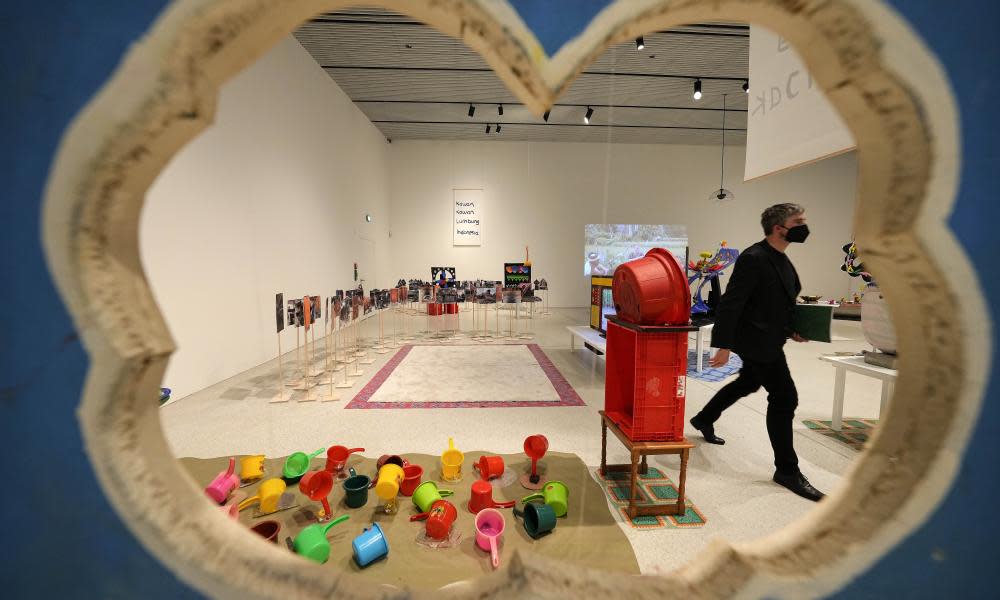Indonesian group first Asian artists to top power list after ‘antisemitic’ mural

An Indonesian collective that became embroiled in an antisemitism row earlier this year has taken the No 1 spot in the annual ranking of the contemporary art world’s most influential people and organisations.
The ruangrupa group, founded in Jakarta in 2000, are the first artists from Asia to top the ArtReview Power 100. Their position “reflects the growing influence of the global south and the move towards greater diversity in the art world,” ArtReview said.
The collective organised this year’s documenta, an important art exhibition that takes place every five years in Germany. The show was controversial and was accused of including antisemitic content.
A large-scale outdoor mural that featured apparently antisemitic caricatures of Jews was removed days after the exhibition opened, and documenta’s general director, Sabine Schormann, resigned.
In a statement posted online several days later, ruangrupa said: “The truth of the matter is that we collectively failed to spot the figure in the work, which is a character that evokes classical stereotypes of antisemitism. We acknowledge that this was our error.”
ArtReview acknowledged that this year’s exhibition had been “continuously mired in controversy about racial and religious prejudice (antisemitism in particular)”. It prompted “heated debates about historical positions … that went all the way to government levels”.
JJ Charlesworth, editor at ArtReview, said: “ruangrupa took the top position because their documenta offered a challenge to the established function of big art exhibitions and conventions of curating – conventions which still drive the Anglo-European art world and the European museum model.
“Part of that is the question of the power of selection, control over who is included and excluded. Pursuing a more devolved, less top-down approach to exhibition-making, in which participants invited other participants in a kind of organisational daisy-chain, was always going to make controversy more likely.
“But ruangrupa’s no 1 position is a recognition of the questions they ask about the institutions of the art world, not the debates provoked by a small number of works included in the exhibition.”
This year’s Power 100 placed unions at No 3 after a wave of disruption at museums and galleries across the world. At No 8, photographer Nan Goldin had “notably instigated a profound shift in the ethics of museum patronage through her campaign to call to account the philanthropy of the Sackler family (closely tied to opioid manufacturers Purdue Pharma)”. Museums and galleries around the world have removed the Sackler name from their buildings in the past year.
Darren Walker, president of the Ford Foundation, at No 10, “steers a philanthropic organisation committing substantial financial resources to the art world’s social justice agendas”.
The Top 10 also included Cecilia Alemani, the Italian curator described as a “disrupting influence” at the Venice Biennale; film-maker Hito Steyerl; cultural theorist Fred Moten; David Zwirner, owner of galleries in New York, London, Paris and Hong Kong; Turner prize-winning photographer Wolfgang Tillmans; and American artist Simone Leigh, the joint winner of the Golden Lion at this year’s Venice Biennale.
Further down the list, Forensic Architecture came in at No 25. The collective “continues to expand the role art has in society beyond the exhibition space through its judicial investigations of social and environmental crimes”, said ArtReview.
The Chinese visual artist Ai Weiwei was ranked at number 51 on the list.
The list is chosen by more than 30 people from across the world, who remain anonymous. Last year, NFTs (non-fungible tokens) topped the list, and Black Lives Matter was No 1 the year before.
The top 10:
1 ruangrupa
2 Cecilia Alemani
3 Unions
4 Hito Steyerl
5 Fred Moten
6 Wolfgang Tillmans
7 Simone Leigh
8 Nan Goldin
9 David Zwirner
10 Darren Walker


